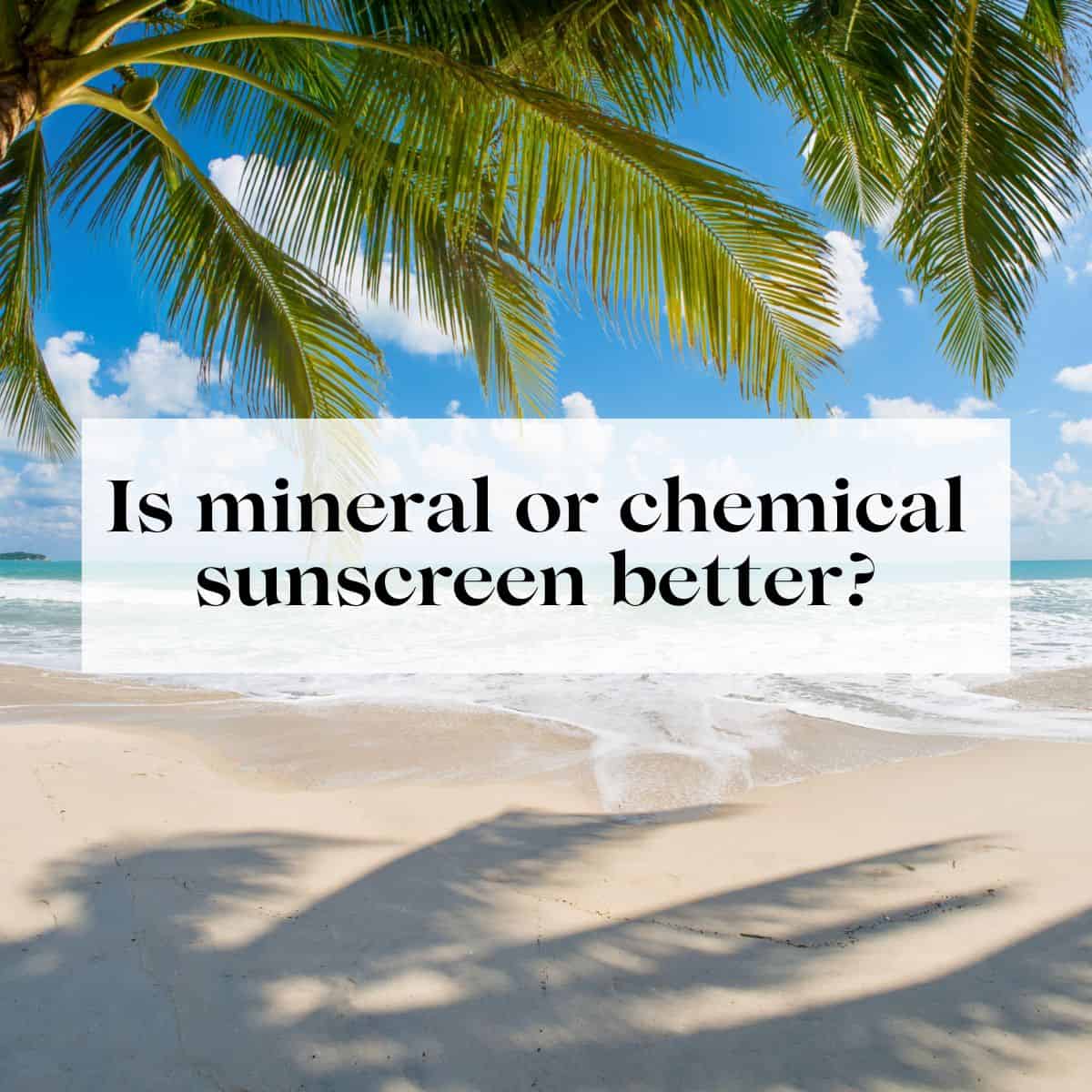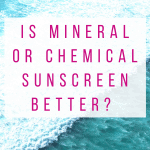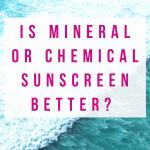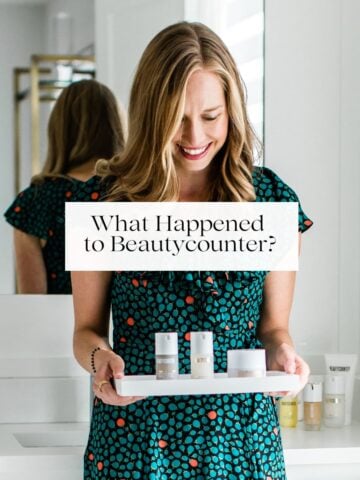Is mineral or chemical sunscreen better? In this post we will review the differences between the two, which one offers better protection from the sun, review how these sunscreens work, how to use them, and which one is better for your health.

Would you like to save this for later?
Disclaimer: some of the links in this post are affiliate links where I make a small commission if you purchase the product through that link. This does not cost you anything extra and helps me keep this website running.
Table of Contents
- Why wear sunscreen?
- How mineral sunscreen works:
- Pros and cons of mineral sunscreens
- Tips for using mineral sunscreens:
- How chemical sunscreens work:
- Pros and cons of chemical sunscreens:
- How to use chemical sunscreens:
- The bottom line: is mineral or chemical sunscreen better?
- Other ways to protect your skin from the sun:
- Frequently asked questions:
- Other health information you will be interested in:
- Our expertise:
Why wear sunscreen?
Wearing sunscreen when you are going to be spending time outdoors is important. Too much sun exposure can cause skin damage, sun burns, blisters, dark spots, wrinkles, aging of the skin, and even skin cancer. This is where sunscreen comes in. Sunscreen can help protect your skin from the damaging effects of too much sun exposure, while still allowing you to enjoy time outside.
But not all sunscreens are created equal. When it comes to the active ingredients in sunscreen - the ones that protect you from the sun's UV rays - there are two different forms: mineral and chemical filters. Each uses a different mechanism for protecting your skin and maintaining stability in sunlight.
The most common sunscreens on the market contain chemical filters but mineral sunscreens are becoming more and more common as people are starting to realize the concerns with the chemical sunscreen ingredients. In this post I will take you through the differences between chemical sunscreens and mineral sunscreens and help teach you which type of sunscreen is better.
How mineral sunscreen works:
Mineral sunscreens work by providing a physical barrier to protect skin from the sun's UV rays. Mineral sunscreens sit on top of the skin, and for this reason they are also sometimes referred to as physical sunscreens. They basically block the sun's rays from getting to your skin, thus preventing the UV rays or UV light from damaging your skin.
The great thing about mineral sunscreen ingredients is that they sit on top of your skin and don't get absorbed into your skin or bloodstream like chemical sunscreens do. This is beneficial because they can’t impact your internal organs or hormones like chemical barriers can and are therefore a healthier and safer option compared to chemical sunscreens.
When it comes to mineral sunscreen filters there are a couple different types: zinc oxide and titanium oxide or titanium dioxide. Zinc oxide is a more effective sunblock when compared to titanium dioxide. You also want to be sure to choose brands that are using non-nano zinc oxide as nano particles can be harmful to our health and are easily inhaled so you want to be sure to avoid them.
Pros and cons of mineral sunscreens
Pros:
There are many pros and benefits to using mineral sunscreens. Most importantly they work well to prevent sunburns, and skin damage from the sun. They offer broad-spectrum protection against both UVA rays and UVB rays from the sun and come in many different SPF options. When it comes to sun protection, the physical or mineral sunscreens offer superior protection when compared to chemical sunscreens.
Another really important thing is that mineral sunscreens are great for health and are the safest type of sunscreen to use.
In fact, the US food and drug administration (or FDA) has recently recommended that mineral sunscreen ingredients are the only ones that can be considered to be both safe and effective. In the FDA's most recent recommendations, of the 16 currently marketed active sunscreen ingredients in North America, only the two mineral sunscreen ingredients – zinc oxide and titanium dioxide – can be generally recommended as safe and effective (GRASE) for use in sunscreens. Two chemical sunscreen ingredients – aminobenzoic acid (PABA) and trolamine salicylate – are not recommended for use in sunscreens due to safety concerns and 12 chemical sunscreen ingredients (cinoxate, dioxybenzone, ensulizole, homosalate, meradimate, octinoxate, octisalate, octocrylene, padimate O, sulisobenzone, oxybenzone, and avobenzone) are not GRASE because of a lack of safety data at this time.
As well, mineral sunscreens are reef-safe. Meaning, they are safe for the coral reefs and are also safe for marine and aquatic life. So not only are they good for our health, but they are good for the environment as well.
Cons:
The biggest con or biggest complaint that people tend to have when it comes to mineral sunscreens is how thick and pasty some of them are and how some of them can leave a white cast on your skin. I've tried a number of mineral sunscreen brands and I can attest that some of them are very pasty and hard to rub in. But after trying many different mineral sunscreens brands I have found one I really like that goes on nice and clear. You can read about my favourite mineral sunscreen here.
Another down side to mineral sunscreen is that some of them can create a white cast or white film on the skin's surface, or look ashy on darker skin tones. Fortunately there are many tinted mineral sunscreens available now so no matter what your skin type or skin tone you should be able to find the right sunscreen formula for you.
One other downside of mineral sunscreens is that sometimes they can be harder to find. However, with the increasing recognition of the health risks and environmental risks of chemical sunscreen ingredients, most drug stores now carry at least some brands of mineral sunscreens and I expect them to become even more available.
Tips for using mineral sunscreens:
No matter what type of sunscreen you are using, the most important thing for them to be effective is to use them properly. One important tip when using mineral sunscreens is to shake them before using them. This is because the zinc oxide and titanium oxide or titanium dioxide will tend to settle at the bottom of the bottle. So to re-distribute these ingredients more evenly throughout the product, simply give the bottle a shake before dispensing.
If you are using a mineral sunscreen spray, simply spray it onto the skin, and then rub it on your skin to distribute it evenly. And if you are using a mineral sunscreen stick, simply apply the sunscreen to your skin. And then rub it in to help distribute it.
The other really important thing to remember when using mineral sunscreens is that you want to apply them 10-15 minutes before going outdoors, and to reapply them regularly. If you are out in the sun you want to reapply your sunscreen every 90-120 minutes and anytime after you’ve been in the water. Or if you’ve been sweating in large amounts. The same applies to face lotions with SPF. Many people are fooled into thinking that their skin will be protected all day if they put their SPF face lotion on in the morning. This just isn’t true. In order to be protected, you would still need to re-apply that product throughout the day, the same as you would for any other SPF product.
How chemical sunscreens work:
Compared to mineral sunscreen, chemical sunscreens or chemical uv filters protect your skin by a different mechanism. Chemical sunscreen ingredients get absorbed into your skin and then absorb UV rays or UV radiation through their chemical bonds. As these chemical compounds absorb UV rays, the components of the sunscreen slowly break down and then release heat from the body.
There are many different types of chemical sunscreen ingredients on the market including oxybenzone, avobenzone, octisalate, octocrylene, homosalate and octinoxate. On their own, chemical sunscreen ingredients don't offer very good protection from the sun and don't work as well as mineral sunscreens or physical sunscreens. This is why you will typically see chemicals sunscreens contain a combination of two to six of these chemical filters or active ingredients to help increase the effectiveness of the product and its ability to protect you from the sun.
Pros and cons of chemical sunscreens:
Pros:
The biggest pro of chemical sunscreens is that they go on nice and clear so are easy to use. They are also readily available and can be found in any drug store, department store or grocery store. They also come in a wide range of SPF options depending on your needs. Chemical sunscreens are also often cheaper than mineral sunscreens, although, this will depend on the brand you choose as there are many expensive chemical sunscreens on the market as well. Board certified dermatologists will also tell you that chemical sunscreens are great for all skin types, including acne prone skin.
Cons:
A major con of chemical sunscreens is that they provide inferior UV protection when compared with physical filters or mineral sunscreens. Because of this, many chemical filters must be combined to provide adequate UV protection, which is why you will see chemical sunscreens containing many different chemical filters.
The biggest con or concerns with chemical sunscreens is that they could be harmful to your health. Unfortunately, the chemical filters can act as hormone disruptors, and they can also cause allergic skin reactions.
As well, studies have shown that topical application of chemical sunscreens leads to plasma concentrations of these ingredients that exceed the safety or toxicology threshold established by the Food and Drug Administration (the FDA).
Of the chemical filters, oxybenzone is likely the most dangerous and most harmful. It can act like an estrogen in the body and has anti-androgenic effects, as well as potentially causing allergic skin reactions. It’s also been linked to birth defects and other pregnancy related health issues.
Oxybenzone and other chemical filters can also end up in breast milk, which is a concern for breast feeding women as it means that your baby then ingests those chemicals.
Besides having potentially negative effects on human health, oxybenzone is also bad for the environment as it destroys the coral reefs and is also toxic to fish and other marine life.
How to use chemical sunscreens:
Like mineral sunscreens, you want to be sure to use chemical sunscreens properly. Apply them 15 minutes before going out in the sun and reapply every 90-120 minutes, or anytime you've been in the water, or sweating in large amounts.
If you use a face lotion with SPF as part of your daily skincare routine, remember that the protection will only last a couple hours after application in the morning so be sure to reapply sunscreen to your face throughout the day as well.
The bottom line: is mineral or chemical sunscreen better?
My personal opinion is that mineral sunscreens are better than chemical sunscreens and are the better choice. Not only do mineral-based sunscreens offer superior broad spectrum protection from the sun compared to chemical sunscreens but they are better for our health and the environment.
Chemical sunscreen ingredients have many potential health concerns, and the FDA has recently stated that none of the chemical sunscreen ingredients available in North America can be considered safe for health.
I am also concerned about the risks of oxybenzone in pregnancy and breast feeding.
And if you aren't sure to start when looking for an effective mineral sunscreen I have written an entire review on the best mineral sunscreen!
Other ways to protect your skin from the sun:
Besides using sunscreen, there are other things you can do to help protect your skin from sun damage including:
- Use a vitamin C serum: Vitamin C serums help decrease the damage you can get from UVA and UVB rays and prevent sun damage by neutralizing free radicals, an effect which is not seen with sunscreens – under laboratory conditions, the application of 10% topical vitamin C shows a reduction of UVB-induced redness by 52% and sunburn cell formation by 40-60%. You can learn more about my favourite vitamin C serum and see my before and after photos here.
- Be cautious with retinol: Using retinol on your skin when you are getting exposed to the sun has been shown to increase the risk of sun damage and skin cancer. And while retinol is often recommended by board certified dermatologists to help deceases the signs of aging and help acne-prone skin it can come with other risks as well.
- Increase your omega-3 intake: Omega 3 supplementation has been found to help treat acne, psoriasis, dry skin, eczema and a number of other skin conditions, and increased omega 3 intake makes you less likely to get a sunburn.
- Wear a hat: If possible wear a hat with a wide brim to help protect the skin on your face, neck and chest as much as possible from the sun.
Frequently asked questions:
If you are going to be spending time outside in the sun and don't want to wear sunscreen, you will need to protect your skin in other ways. You can use a wide brimmed hat to protect your face, and you can wear clothing to protect the skin on your body. Just remember that any exposed skin is at risk for getting sun damage. The other option is to stay in the shade or stay indoors.
The best non-toxic sunscreens are those made with non-nano zinc oxide and that are free from benzene, parabens, phthalates and fragrances. You can read how to choose a non-toxic sunscreen here and read about my favourite non toxic sunscreen here.
Other health information you will be interested in:
- Is there mercury in your mascara?
- Is there benzene in your sunscreen?
- How to choose safe cookware
- Are candles toxic?
Our expertise:
Dr. Erin Carter, MD, FRCPC, is a physician with board certifications in internal medicine and rheumatology. She is passionate about nutrition, environmental health and low toxicity living and has been researching and publishing information in this area for years. She is also a self-trained chef and has been creating and publishing recipes since 2015. Her recipes have been featured on many different websites and online publications.







Leave a Reply